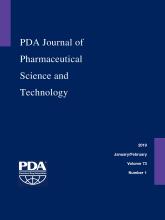Abstract
Capping completes the closure of parenteral drug products in the final packaging container and is critical in maintaining an integral seal to ensure product quality. Residual seal force (RSF) is considered the sole quantifiable attribute for measuring seal “goodness” and potentially enables nonsubjective, consistent setting of cappers across manufacturing sites. However, the consistency and reliability of RSF measurement and data have been scarcely reported, and the relationship between RSF and container closure integrity (CCI) remains poorly understood.
Here, we present a large data set generated from a commercial capper and the results from a laboratory capper of glass vials and rubber stoppers with aluminum caps. All RSF values exhibited significant variability. We evaluated four potential sources of variability: the capper, the RSF tester, the time-dependent nature of RSF, and the components. We determined that the capper, the tester, and the time-dependent nature are not main sources. Dimensional tolerances of the packaging components were the root cause for the container closure system (CCS) configurations tested in this study.
This study correlated RSF with CCI (via helium leakage), although CCI is not sensitive to RSF; CCI was maintained even for loosely capped vials with no measurable RSF. This was attributed to the stopper's two sealing surfaces: the valve seal and the land seal. A methodology capable of differentiating the two seals' functions demonstrated that vials with only the valve seal always passed leakage testing for a selected CCS configuration in this study, while vials with only the land seal failed CCI at low RSF values. This observation allows proposal of a low RSF limit that is safe even when the valve seal is defective. Simplified statistical analysis of commercial capping data, with the input of sample size, allowed the relationship between RSF's low limit and an allowable failing rate to be established. Overall, despite the inherent variability of RSF, this study shows that it is a feasible parameter for capping process quantification and demonstrates the potential of RSF measurement in capper setup.
LAY ABSTRACT: Pharmaceutical vials are typically closed off with an elastomeric stopper that is secured onto the vial with an aluminum crimp cap (or seal) such that the entire assembly is meant to protect the vial's contents from external contamination. Therefore, the capping process is critical for ensuring container closure integrity. Characterizing the effectiveness of a seal in a nonsubjective and quantifiable manner is challenging. In this communication, we report the evaluation of residual seal force measurements (the compression force that the crimp cap exerts on the stopper) to evaluate capping for a large set of samples generated on both an at-scale commercial capper and a benchtop laboratory capper. We propose a test methodology, based on a statistical approach, for establishing permissible lower residual force limits that would provide a high degree of confidence to the capping process. This is a useful tool for consistent capper setup and capping process quantification.
- Residual seal force
- RSF
- Vial capping
- Container closure integrity
- CCI
- Primary packaging components
- Helium leakage
- Vial
- Stopper
- Crimp cap
- © PDA, Inc. 2019
PDA members receive access to all articles published in the current year and previous volume year. Institutional subscribers received access to all content. Log in below to receive access to this article if you are either of these.
If you are neither or you are a PDA member trying to access an article outside of your membership license, then you must purchase access to this article (below). If you do not have a username or password for JPST, you will be required to create an account prior to purchasing.
Full issue PDFs are for PDA members only.
Note to pda.org users
The PDA and PDA bookstore websites (www.pda.org and www.pda.org/bookstore) are separate websites from the PDA JPST website. When you first join PDA, your initial UserID and Password are sent to HighWirePress to create your PDA JPST account. Subsequent UserrID and Password changes required at the PDA websites will not pass on to PDA JPST and vice versa. If you forget your PDA JPST UserID and/or Password, you can request help to retrieve UserID and reset Password below.






